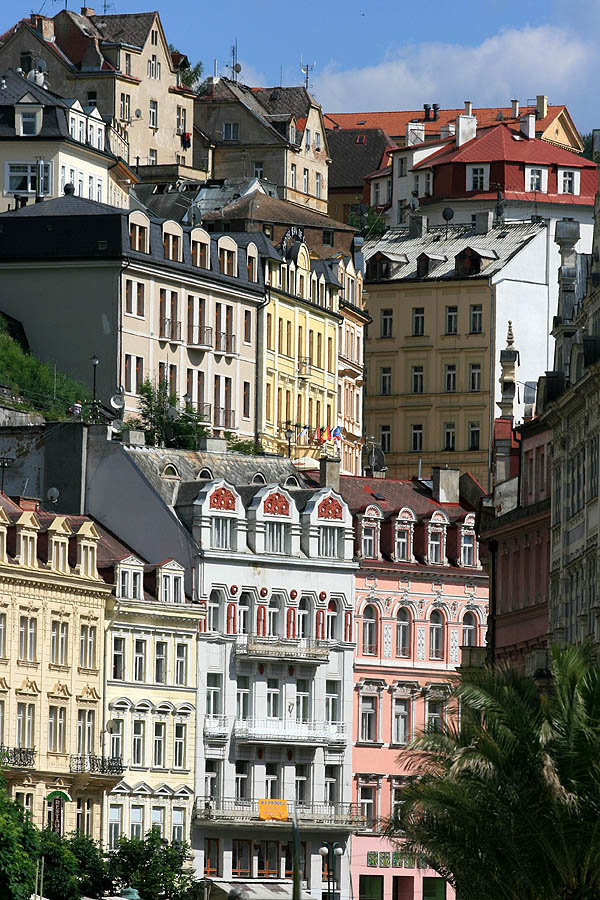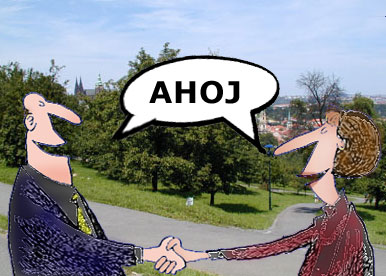After I graduated from college a little over a decade ago, I had to
figure out what I wanted to do with my bachelor’s degree in general music
(non-teaching) and a minor in linguistics and English and Teaching English as a
Second Language (although the last two were undeclared). I found this program –
I forget the name now – where I could travel to one of three European cities to
take a 4-6 week course that taught how to teach ESL and then they’d place you
in a school somewhere to teach English. Since I was fresh out of college, I
wasn’t able to come up with the money required for housing, tuition, and
airfare to get to Europe. But when I was thinking about it, I wanted to do the
program in Prague, Czech Republic. I was so serious about it, in fact, that I
bought myself a book on learning Czech (I still have it on my shelf). I really
do love the Slavic languages – I may start learning Czech next, right after I
master Portuguese and Spanish. And as a music major, one of my all-time
favorite composers is Antonin Dvorak, a Czech.
The Czech Republic lies in central Europe, surrounded by Germany, Poland,
Slovakia and Austria. The country
itself is landlocked, but several major river systems and their tributaries
meander their way through the country: the Elbe, Vltava, Ohre, Danube, Morava,
Thaya, and Oder. These rivers either drain into the North Sea, Black Sea, or
Baltic Sea. Rolling hills, forests, and farmland cover most of the
countryside. The climate is
generally temperate with hot, rainy summers and cold, snowy winters – not
unlike most of the Midwest United States.
The area now known as the Czech Republic once was the independent states
of Bohemia, Moravia, and Silesia.
I’ve often used the term “bohemian,” meaning someone (especially
artists, musicians, writers, etc) who live unconventionally. (Actually, the term was originally
French, in reference to the Romani people who they thought were from Bohemia.
Some may have been, but many of the Romani or Roma people were from Romania and
Bulgaria and other areas. The English term “gypsy” was from a belief that these
tribes originated in Egypt, from a Middle English word “gypcian.”) The famous
Duke of Bohemia, Wenceslaus I, is the subject of the Christmas carol “Good King
Winceslaus.” He was murdered by
his brother in 935 AD after an argument and subsequently overtook the
title. The Black Death which took
its toll on Europe during the mid-1300s, completely devastated Bohemia; some
estimates say 10% of the population perished in this horrific outbreak.
During the 1500s, it fell under the Hapsburg Empire, and later the
Austrian Empire, and then Austria-Hungary. After WWI, these states together
became Czechoslovakia (which is how I learned it growing up). During WWII, Germany invaded Bohemia
and Moravia and turned it into a protectorate. The Nazis were brutal to the Czechs, killing many and
shipping other out to kill them in other countries. So it was natural that there was an anti-Nazi resistance
towards their occupation. Even
after WWII ended, Czechoslovakia remained a Communist state until 1989. The term “Velvet Revolution” is often
used when describing the non-violent transition from a single-party state to a
democracy. Four years later,
Czechoslovakia itself will be no more, but as the separate countries of the Czech
Republic and Slovakia, also separating peacefully. Since then, the Czech
Republic has enjoyed a growing economy and high quality of life.
Sitting on the Vltava River, the capital city is
Prague (called Praha in Czech), a city of around 2 million people if you count
the larger metro area. Prague is
known for its architecture – from Gothic to modern – and especially for its
cathedrals (one of its nicknames was “City of a Hundred Spires.”) Prague is not
only the center of government, but also a center for the arts: from music and
theatre to art and literature.
 |
| Prague Castle |
The Czech Republic is highly developed and has a
high-income economy. In comparison
with other post-Communist states, the Czech Republic is one of the more stable
ones today. Its infrastructure is
vastly improved with airports, railways, and extensively paved roadway systems.
They also enjoy having one of the fastest Internet speeds and have the largest
number of Wi-Fi subscribers in the EU (one more reason I should retire to live
in Prague). The Czech Republic has long been a hot bed for scientific
research. Some of the more famous
Czech scientists include such celebrities as Gregor Mendel (“father of modern
genetics,” the only part of high school Biology that truly interested me), Jakub Krystov Rad (inventor of sugar cubes), Jan Jansky (discovered
the classification of blood types), Josef & Karel Capek (invented the word
“robot” – not exactly scientific for coining a word, but I’m including it), and
Otto Wichterle & Draholav Lim (inventors of the modern contact lens – I thank
them everyday). Tourism is pretty
important as well – the country in general has a fairly low crime rate. Castles
(they have over 2000 of them!), cathedrals, museums, theatres, puppet
festivals, and beer festivals are all pretty popular destinations.
The official and most widely spoken language is
Czech, a West-Slavic language. Before the 20th century, it was known
as Bohemian in English. It’s closely related to and mutually intelligible with
other Slavic languages. Actually, there’s a variety of Czech spoken in Texas
which I had no idea existed, but apparently there were a lot of Czechs who
immigrated there during the late 1800s.
However, there are a lot of other languages that are officially listed a
minority languages: Slovak, German, Polish, Belarusian, Bulgarian, Croatian,
Greek, Hungarian, Romani, Russian, Rusyn, Serbian, Ukrainian, and
Vietnamese. The vast majority of
Czechs describes themselves as indifferent to religion, or just simply believes
in a spiritual or life force outside of any kind of organized religion. Of the remaining religious folk, the more
people adhere to Catholicism while a smaller percentage is Protestant.
This country is surprising, and I’m in awe of what I
didn’t know. For instance, 90% of Czechs graduate from high school, compared
with only about 75% of Americans (and even the highest ranking state, Vermont,
only graduated 85%) And I’m embarrassed to say that’s a 40-year peak for
us. Unfortunately, Czechs also
have the second-highest death rate for cancer in the EU – but on the plus side,
the Czech Republic has the most hospital beds per inhabitant in the EU. Czechs also have a serious passion for
mushroom hunting. I know a few who do this, but I never have gone mushroom
hunting myself. I would have no idea what I’m looking for. I do know that I’m
looking forward to making kolaches. There’s a place on the north side of
Indianapolis called Kolache Factory, but I never went inside because I didn’t
know what a kolache was. Now, I’m waiting to go after I make my own. I’m very
excited about writing on the Czech Republic, the world’s largest consumers of
beer. I end this post as I grab me
another cold one from the fridge.
Up next: holidays and celebrations







No comments:
Post a Comment